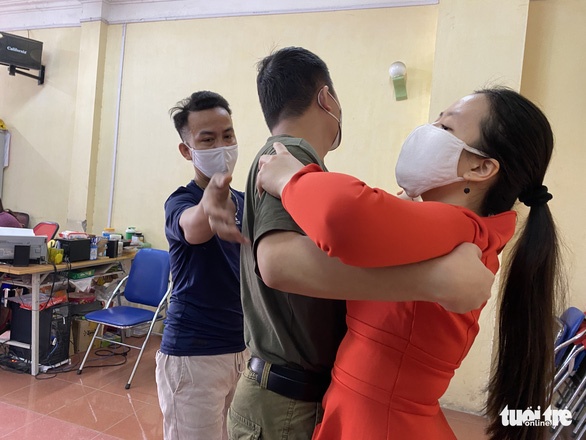An Nhu, a 18-year-old from the Vietnam National Academy of Music, checks in early to maximize her practice time even though her dancesport class does not start until 8:00 am.
“The teacher is amazing,” she referred to her dancesport instructor.
“He helps us approach dancing with joy.
“Every time I come to the class, I feel happier and more confident.”
Parting with the old way
To Van Hoa, a 38-year-old athlete, came up with the idea for a dancesport class for the blind three years ago while he was joining a project that promoted vocational training for visually disabled people.
After the project came to an end, he decided to continue working with the blind.
For the last three years, he has been active in classes from 8:00 to 9:30 am every Wednesday and Friday.
“Dancesport is challenging even to a normal person, and is extremely tough for the blind,” he said.
“To make up for that, they can feel the music, the space, and the instructions very accurately.
“They strive to accomplish.
“That motivates me to work here.”
To approach dancesport the way he does, Hoa had to get rid of the old methods.
He needs a constant update in his instructions and way of communication with the disabled students so that they can listen to and feel their own bodies.
The biggest hurdle is the physical area for the class.
They do not get to practice in a professional dance room, but gather in the third-floor hall of the Blind Association in Dong Da District, Hanoi.
To make space, tables and chairs are simply pushed to the sides.
At times, the students might bump into the furniture because they get so carried away by their dancing moves.
But they do not step down.
Hoa is there to provide guidance for every step, enabling them to identify the surrounding space and solve problems promptly.
“I have to put myself in their shoes and try to help them feel their bodies,” said the instructor.
“Every move and gesture is mixed with music to create basic dance moves.”
Despite his packed schedule being a dancer, a dance teacher and doing other jobs, Hoa still makes time for this blind dancing class.
He hopes to bridge the gap between the students and to inspire them along the way.
“The disabled never stop trying whatever challenge they face,” he said.
Listening to their bodies
Dinh Duc Thiep, 26, registered for Hoa’s class four months ago.
Dancesport has boosted his communicative confidence, spirits, and physique.
Most importantly, he found a community of other people just like him.
“Though we cannot see him, we sense his instructions by ear. He has his own way of guiding us,” he said.
“The normal person will watch and learn, while we get direct and hands-on instructions from the coach.
“We might be slower but the teacher perseveres in his instruction so we can get things done right.”
Do Thuy Ha, president of the Blind Association in Dong Da District, is one of Hoa’s students.
She has mastered the dance moves and is ready to act as Hoa’s teaching assistant.
“He has brought to us a breath of fresh air and is whole-heartedly committed,” said Ha.
“To kindly respond, we try hard to achieve the best results.”
With over 20 years of experience working in dancing and sport, Hoa hopes to pass on his knowledge to the visually impaired students using his own methods that are grounded basically on each student’s background.
During the lockdown amid the COVID-19 pandemic’s impact on Vietnam, the on-site dance class had to stop.
Hoa, however, took things online so that the students could stay fit during the long break.
The number of students has increased gradually over three years.
This means a larger room or space is needed.
The instructor and his students, however, keep on practicing even though they have yet to find a new space.
A message of perseverance
In April 2021, Hoa’s students and other visually impaired citizens in Hanoi signed up for ‘The dance that bridges the gap’ – a dancing contest organized by SoLAR, a city-based dance club for the blind.
This event was launched with support from the Hanoi Association for the Blind, the REACH Group, and instructor Hoa himself.
It was the first dancesport competition held for the blind in Vietnam.
“The contest left a special mark of impression,” said Hoa.
“Through it, we hope to send a message: ‘Vietnamese people, in all of their circumstances, try their best and realize their own mission.’”
Like us on Facebook or follow us on Twitter to get the latest news about Vietnam!




